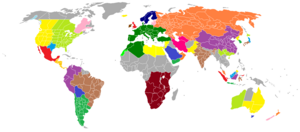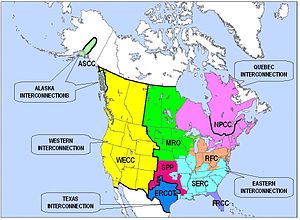
Back Wide area synchronous grid Catalan Verbundnetz German شبکههای همزمان کلان Persian Региональная синхронная сеть Russian
A wide area synchronous grid (also called an "interconnection" in North America) is a three-phase electric power grid that has regional scale or greater that operates at a synchronized utility frequency and is electrically tied together during normal system conditions. Also known as synchronous zones, the most powerful is the Northern Chinese State Grid with 1,700 gigawatts (GW) of generation capacity, while the widest region served is that of the IPS/UPS system serving most countries of the former Soviet Union. Synchronous grids with ample capacity facilitate electricity trading across wide areas. In the ENTSO-E in 2008, over 350,000 megawatt hours were sold per day on the European Energy Exchange (EEX).[1]
Neighbouring interconnections with the same frequency and standards can be synchronized and directly connected to form a larger interconnection, or they may share power without synchronization via high-voltage direct current power transmission lines (DC ties), solid-state transformers or variable-frequency transformers (VFTs), which permit a controlled flow of energy while also functionally isolating the independent AC frequencies of each side. Each of the interconnects in North America is synchronized at a nominal 60 Hz, while those of Europe run at 50 Hz.
The benefits of synchronous zones include pooling of generation, resulting in lower generation costs; pooling of load, resulting in significant equalizing effects; common provisioning of reserves, resulting in cheaper primary and secondary reserve power costs; opening of the market, resulting in possibility of long term contracts and short term power exchanges; and mutual assistance in the event of disturbances.[2]
One disadvantage of a wide-area synchronous grid is that problems in one part can have repercussions across the whole grid.
- ^ "EEX Market Monitor Q3/2008" (PDF). Leipzig: Market Surveillance (HÜSt) group of the European Energy Exchange. 30 October 2008. p. 4. Archived from the original (PDF) on 2011-07-10. Retrieved 2008-12-06.
- ^ Haubrich, Hans-Jürgen; Dieter Denzel (2008-10-23). "Characteristics of interconnected operation" (PDF). Operation of Interconnected Power Systems (PDF). Aachen: Institute for Electrical Equipment and Power Plants (IAEW) at RWTH Aachen University. p. 3. Archived from the original (PDF) on 2011-07-19. Retrieved 2008-12-06. (See "Operation of Power Systems" link for title page and table of contents.)
© MMXXIII Rich X Search. We shall prevail. All rights reserved. Rich X Search


